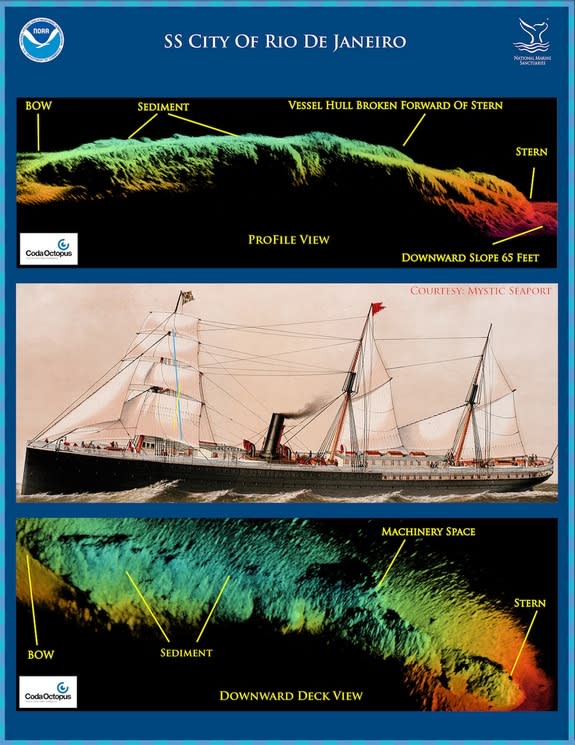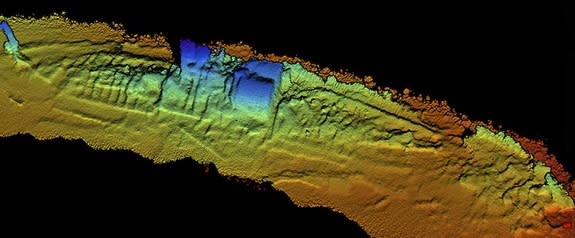Golden Gate's Deadliest Shipwreck Located
In dark waters just outside the Golden Gate Bridge, archaeologists have pinpointed the final resting place of the worst shipwreck in San Francisco's history.
New sonar maps show for the first time the mud-covered grave of the SS City of Rio de Janeiro, nearly 300 feet (91 meters) below the surface. The steamer sank on Feb. 22, 1901, just before reaching its destination, with 210 people on board, most of them Chinese and Japanese immigrants.
"The overwhelming response looking at the imagery of the Rio is one of sadness," said James Delgado, director of maritime heritage for National Ocean and Atmospheric Administration's (NOAA) Office of National Marine Sanctuaries. When the ship sank, "it was front-page news all over the world. It was a terrible tragedy," he said. [See Photos of Sunken Ships Near San Francisco]
The City of Rio spent two months at sea, making stops in Hong Kong; Yokohama, Japan; and Honolulu before returning to San Francisco. On the morning of the accident, pilot Frederick Jordan had been steering the 345-foot (105 m) steamer through the Golden Gate strait (three decades before construction on the bridge started). But under heavy fog, the City of Rio struck jagged rocks near Fort Point, at the southern end of the strait. The ship was badly damaged and sank within just 10 minutes, trapping many passengers riding in the cabin and in steerage. In total, 128 people were killed.
In the 1980s, a salvage team claimed to have found the shipwreck. However, the team lost its equipment trying to reach the underwater site, and later, it turned out that the coordinates the team recorded didn't match up with those of the wreck site, Delgado said.
Last month, the companies Hibbard Inshore and Bay Marine Services donated a research vessel and crew to NOAA for a day. The agency used the opportunity to look for the City of Rio using a 3D sonar device known as Echoscope developed by the company Coda Octopus. NOAA was able to find and map the City of Rio, and the crew even had time to map the nearby SS City of Chester, a wreck that was recently rediscovered.
The City of Chester, destined for Eureka, California, went down on Aug. 22, 1888, after colliding with the RMS Oceanic, a ship that was arriving from Asia. Of the 90 people on board, 16 were killed. Delgado and his team thought the City of Chester would be buried in mud, but instead, it's quite exposed, with its boilers and engines still mounted in place.
"You see the bones of the ship laid out," Delgado said. "You see the machinery in place in an environment that would otherwise be completely unknown and inaccessible."
In contrast, the City of Rio is in bad shape. The vessel is collapsing under a thick layer of mud. At some point since it sank, the ship's front half broke off and slid down a 65-foot (20 m) slope. Even without its mud coating, the ship would be nearly impossible to salvage with current technology because of its depth and the strong currents surrounding the wreck, Delgado said. In his view, the City of Rio is in a "sealed grave."
There are hundreds of shipwrecks just west of the Golden Gate Bridge. NOAA has recently embarked on a two-year mission to find and document those lost vessels in Gulf of the Farallones National Marine Sanctuary and Golden Gate National Recreation Area. Agency officials say they've plotted about 200 wrecks so far.
Follow Megan Gannon on Twitter. Follow us @livescience, Facebook & Google+. Original article on Live Science.
Copyright 2014 LiveScience, a TechMediaNetwork company. All rights reserved. This material may not be published, broadcast, rewritten or redistributed.





